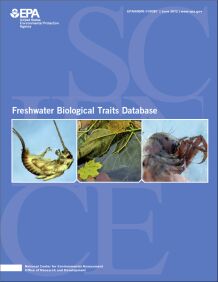Freshwater Biological Traits Database (Traits)
On this page:
About Traits
The Freshwater Biological Traits Database currently contains traits data for 3,857 North American macroinvertebrate taxa, and includes habitat, life history, mobility, morphology and ecological trait data. These data were compiled for a project on climate change effects on river and stream ecosystems. The traits data were gathered from multiple sources, which are listed on the web site under, "Data Source". Data gathering efforts focused on data that were published or otherwise well-documented by trustworthy sources, accessible, appropriate for the regions being studied, in a standardized format that could be analyzed or easily converted to a format that could be analyzed, and ecologically relevant to the gradients being considered.
Background Information
For this project, data gathering efforts focused on data that were published or otherwise well-documented by trustworthy sources, accessible, appropriate for the regions being studied, in a standardized format that could be analyzed or easily converted to a format that could be analyzed, and ecologically relevant to the gradients being considered. The 14 data sources that have been integrated into the Traits database, along with information associated with these sources, are listed on the page, Traits - Data Sources and Metadata. The main sources are the USGS traits database (Vieira et al. 2006) and the Poff et al. trait matrix (2006). Also included in the database are thermal optima and tolerance data that were generated from weighted average or generalized linear model calculations that were performed on biomonitoring data from a number of different states. Weighted average inference is a simple, robust approach for estimating the central tendencies of different taxa, or in our case, optima and tolerance values (Yuan 2006).
Due to the substantial effort it took to gather all of this traits data into one place, we have integrated the traits data into one searchable database to make it available to everyone. The Traits Database currently contains location, habitat, life history, mobility, morphology and ecological trait data, along with tolerance calculations for temperature and flow. Data types vary, and include binary, categorical, and text notes entries. There are currently 11,912 unique records contained in Traits for 3,857 different taxa. Levels of taxonomic resolution vary.
History
| Date | Milestone |
|---|---|
| Jul 2012 | EPA released the final report and database. |
| Apr 2011 | EPA released the external review draft report for public review and comment. |
| Aug 2009 | EPA performed an internal review of the draft report. Then held regional workshops to discuss using the traits database. |
Resources
Literature Cited:
- Poff, N.L., J.D. Olden, N.K.M. Vieira, D.S. Finn, M.P. Simmons, and B.C. Kondratieff. 2006. Functional trait niches of North American lotic insects: traits-based ecological applications in light of phylogenetic relationships. Journal of the North American Benthological Society 25(4):730-755 (Trait Matrix, Appendix)
- Vieira, N.K.M., N.L. Poff, D.M. Carlisle, S.R. Moulton II, M.K. Koski, and B.C.Kondratieff. 2006. A database of lotic invertebrate traits for North America: U.S. Geological Survey Data Series 187.
- Yuan, L. L. Estimation and Application of Macroinvertebrate Tolerance Values (Final). U.S. Environmental Protection Agency, Washington, D.C., EPA/600/P-04/116F.
For assistance/questions about this site please use the Traits Contact Us page. For general risk assessment questions, separate from the Traits Database, please use the link below.

